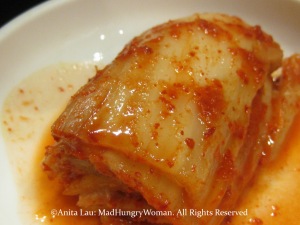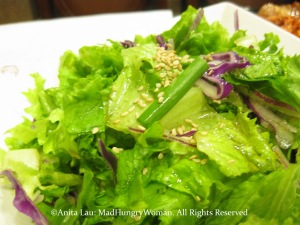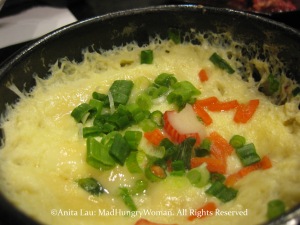>
 |
| chadol baegi (beef brisket) |
When Go Goo Ryeo first opened we used to come here a lot. I then stopped coming when management changed, then the owners changed, and I stopped coming. This year, my friend Evelyn told me that she and her family have been coming here a lot and that they were pretty good, so we re-visited and truly, they have definitely improved to the original quality.
My son loves to eat Korean barbecue and bugs me to take him. It’s been months since his last visit, so when he was craving it this weekend, II took him for lunch to satiate his cravings.
Ordinarily, I would order a la carte if there were only a few of us. If there were more in our party, I’d opt for the all-you-can-eat option so there wouldn’t be a lot of bickering as to what meats to order since there is a little of everything. We usually only eat the chadol baegi (beef brisket) and jumuluk (boneless seasoned short rib), but the all-you-can-eat also includes chicken, taegi bugolgi (spicy pork) and bugolgi (marinated beef) if you want them.
The quality of the AYCE here is the best you’ll find. Most AYCE places will give you the lower cuts of meat, poorer quality, fattier meats but here, the meats are lean and good cuts. I was surprised on my first visit back recently that the chadol baegi was nice and lean instead of half fat.
 |
| napa cabbage kimchi |
The servers will come and help you cook the meat and they refill the banchan (side dishes) when you ask. Usually for a la carte, they will bring out more varieties of banchan. For AYCE, about 6-8 types are offered and if there is something you particularly want, they will bring them out if you ask.
We had two types of kimchi, the regular napa cabbage kind as well as the musaengchae (julienned daikon) marinated in a vinagrette and chili. Regular napa kimchi was very ripe so tasted very sour. I don’t mind this if it sits on the grill for a minute or two on each side. Cooking it cuts down the acidic level of the kimchi and makes it more bearable. Some Korean restaurants offer kimchi which hasn’t been fermenting for a long time so it is very crunchy and lack the depth of flavor, however, I think this appeals more to unseasoned kimchi eaters, although I know a few Korean friends who don’t like it this fermented either.
Peppers with miso was a hit and we had to ask for refills about four times. Korean peppers are boiled and then mixed with a mild miso paste giving it a rich salty finish.
 |
| salad with vinaigrette |
One of our favorite banchan is pajun (pancake). Most of the time if you order this dish in a restaurant it will come with a variety of seafood and vegetables mixed in. As a banchan it is generally made with only scallions. I like to put mine on the grill for a few minutes on each side to get them crispy again before eating.
Kongnamul is a banchan using boiled soy bean sprouts which are tossed in soy sauce and sesame oil. This was my son’s favorite banchan until he found out he liked kimchi. It is crunchy and flavorful and usually very mild, sort of like bean sprouts but with a crunchier texture.
Pickled cucumbers remind me of the kind we have in Chinese cuisine. Usually we eat this with jook (rice porridge) for breakfast. The salty sweet flavors goes really well with the bland soupy rice. There is also a green salad offered with a light vinaigrette which is highly refreshing after the grilled meats.
 |
| meat and condiments atop dduk |
Other condiments include muu (pickled radish discs) and dduk (rice paper) which are used as wrappers for the cooked meats. Basically you can package your final morsel any way you choose. I like it sometimes with dduk and sometimes with muu. If I wanted to stay away from carbs, muu is the best way to go. The vinegary radish discs help cut down on the fatty content of the meat making it possible to for me to consume more than if I were to just eat the meat on its own or with dduk.
Gyeran-jjim (egg custard stew) and dwenjangjigae (bean paste soup) are both complimentary and served in a scorching stone pot. These two gives a “soup” element to an otherwise “dry” meal. I love dwenjangjigae and often will ask for refills. They are very generous here and will always comply. I like eating this piping hot. The soup consists of tofu cubes, onions, zucchini and is on the salty side.
 |
| gyeran-jjim (egg custard stew) |
Rice is available if you ask, but I usually will ask for nurungji bap (burnt rice soup) instead of rice. It takes them a little while to prepare this but it is well worth the wait. Scorched rice is used to make this and the watery consistency is an excellent finish to an otherwise heavy meal. I eat this with the remainding banchan or the remaining dwenjangjigae because on its own, it is bland except for that hint of smokiness which comes from the burnt rice.
At $16.99 the all-you-can-eat is very reasonable and the best way to go if you are new to this. A la carte barbecue items start at $17.99 per order and although one order is generally enough for one person, it limits the different meats you can try.
The staff at Go Goo Ryeo all speak English and service is very good. They are helpful and courteous and unless I want to drive to Koreatown up in LA this, at the moment, is the best Korean barbecue in Orange County. Best of all, all the grills utilize a ‘suck down’ ventilation system which doesn’t leave you smelling like the meal you just had when you are done.
Go Goo Ryeo, 8851 Garden Grove Blvd, Garden Grove, CA 92844. Tel: 714-638-5959








>What are the dipping sauces like? Do they have an oil+salt+pepper option, like at Shik Do Rak?
>Yes they do have the salt and pepper with sesame oil option. Actually most restaurants do, and if they don't give it to you, you can ask them for it.